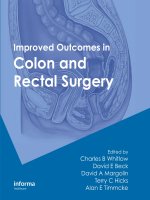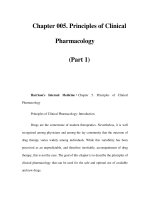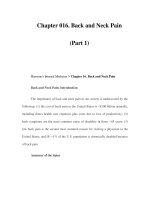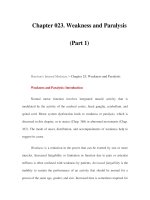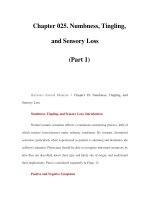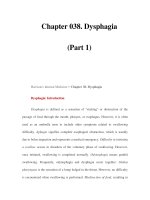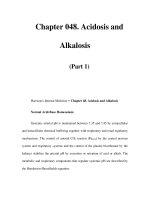Essential Urology - part 1 pps
Bạn đang xem bản rút gọn của tài liệu. Xem và tải ngay bản đầy đủ của tài liệu tại đây (391.21 KB, 22 trang )
A Guide to Clinical Practice
Humana Press
Edited by
Jeannette M. Potts, MD
Essential
Urology
ESSENTIAL UROLOGY
Potts_FM_Final2 12/16/03, 11:32 AM1
CURRENT CLINICAL UROLOGY
Eric A. Klein, MD, SERIES EDITOR
Essential Urology: A Guide to Clinical Practice, edited by Jeannette M. Potts, 2004
Management of Prostate Cancer, Second Edition, edited by Eric A. Klein, 2004
Management of Benign Prostatic Hypertrophy, edited by Kevin T. McVary, 2004
Laparoscopic Urologic Oncology, edited by Jeffrey A. Cadeddu, 2004
Essential Urologic Laparoscopy: The Complete Clinical Guide, edited by
Stephen Y. Nakada, 2003
Pediatric Urology, edited by John P. Gearhart, 2003
Urologic Prostheses: The Complete Practical Guide to Devices, Their Implantation,
and Patient Follow-Up, edited by Culley C. Carson, III, 2002
Male Sexual Function: A Guide to Clinical Management, edited by
John J. Mulcahy, 2001
Prostate Cancer Screening, edited by Ian M. Thompson, Martin I. Resnick,
and Eric A. Klein, 2001
Bladder Cancer: Current Diagnosis and Treatment, edited by Michael J. Droller,
2001
Office Urology: The Clinician’s Guide, edited by Elroy D. Kursh
and James C. Ulchaker, 2001
Voiding Dysfunction: Diagnosis and Treatment, edited by Rodney A. Appell,
2000
Management of Prostate Cancer, edited by Eric A. Klein, 2000
Potts_FM_Final2 12/16/03, 11:32 AM2
ESSENTIAL
UROLOGY
A GUIDE TO CLINICAL PRACTICE
Edited by
JEANNETTE M. POTTS, MD
Glickman Urological Institute, Cleveland Clinic Foundation,
Cleveland, OH
HUMANA PRESS
TOTOWA, NEW JERSEY
Potts_FM_Final2 12/16/03, 11:32 AM3
© 2004 Humana Press Inc.
999 Riverview Drive, Suite 208
Totowa, New Jersey 07512
www.humanapress.com
For additional copies, pricing for bulk purchases, and/or information about other Humana titles, contact Humana at the
above address or at any of the following numbers: Tel.: 973-256-1699; Fax: 973-256-8341, E-mail: ;
or visit our Website:
All rights reserved.
No part of this book may be reproduced, stored in a retrieval system, or transmitted in any form or by any means,
electronic, mechanical, photocopying, microfilming, recording, or otherwise without written permission from the
Publisher.
All articles, comments, opinions, conclusions, or recommendations are those of the author(s), and do not necessarily reflect
the views of the publisher.
Due diligence has been taken by the publishers, editors, and authors of this book to assure the accuracy of the information
published and to describe generally accepted practices. The contributors herein have carefully checked to ensure that the
drug selections and dosages set forth in this text are accurate and in accord with the standards accepted at the time of
publication. Notwithstanding, as new research, changes in government regulations, and knowledge from clinical experi-
ence relating to drug therapy and drug reactions constantly occurs, the reader is advised to check the product information
provided by the manufacturer of each drug for any change in dosages or for additional warnings and contraindications.
This is of utmost importance when the recommended drug herein is a new or infrequently used drug. It is the responsibility
of the treating physician to determine dosages and treatment strategies for individual patients. Further it is the responsi-
bility of the health care provider to ascertain the Food and Drug Administration status of each drug or device used in their
clinical practice. The publisher, editors, and authors are not responsible for errors or omissions or for any consequences
from the application of the information presented in this book and make no warranty, express or implied, with respect to
the contents in this publication.
Production Editor: Robin B. Weisberg
Cover illustration layout by Jeannette M. Potts. Cover illustration by Michelle Wolf. Cover design by Patricia F. Cleary.
This publication is printed on acid-free paper.
ANSI Z39.48-1984 (American National Standards Institute) Permanence of Paper for Printed Library Materials.
Photocopy Authorization Policy:
Authorization to photocopy items for internal or personal use, or the internal or personal use of specific clients, is granted
by Humana Press Inc., provided that the base fee of US $25.00 per copy is paid directly to the Copyright Clearance Center
at 222 Rosewood Drive, Danvers, MA 01923. For those organizations that have been granted a photocopy license from
the CCC, a separate system of payment has been arranged and is acceptable to Humana Press Inc. The fee code for users
of the Transactional Reporting Service is: [1-58829-109-X/04 $25.00].
Printed in the United States of America. 10 9 8 7 6 5 4 3 2 1
E-ISBN 1-59259-737-8
Library of Congress Cataloging-in-Publication Data
Essential urology : a guide to clinical practice / edited by Jeanette M.
Potts.
p. ; cm. (Current clinical urology)
Includes bibliographical references and index.
ISBN 1-58829-109-X (alk. paper)
1. Genitourinary organs Diseases.
[DNLM: 1. Urologic Diseases. 2. Urogenital Diseases. WJ 140 E78
2004] I. Potts, Jeanette M. II. Series.
RC871.E883 2004
616.6 dc22
2003016746
Potts_FM_Final2 12/16/03, 11:32 AM4
To my children, Bradley and Ellen,
and to my mentors, Jonathan Ross,
MD and Elroy Kursh, MD
Dedication
Potts_FM_Final2 12/16/03, 11:32 AM5
Potts_FM_Final2 12/16/03, 11:32 AM6
Preface
vii
As a medical urologist with a background in family medicine, I have enjoyed the
overlapping aspects of urology and primary care. Urological diseases are often brought
to the attention of primary care providers who must then diagnose and manage these
disorders. Essential Urology: A Guide to Clinical Practice is intended to provide support
to primary care physicians through its review of common genitourinary problems. It is
meant to enhance the recognition of urological disease as well as outline current manage-
ment strategies.
Disorders of the urinary tract may be encountered during pregnancy, either as a maternal
diagnosis or as a fetal anomaly detected in utero. Children as well as adults require screening
and monitoring of genitourinary disorders, some of which are gender-specific. Urinary tract
infections may be manifestations of risk factors, anatomical or functional abnormalities,
specific to age and/or gender. These issues are presented in this text. Hematuria, frequently
encountered in the primary care setting as an incidental finding, is discussed in a comprehen-
sive chapter, followed by related chapters detailing urological imaging studies and the evalu-
ation and management of nephrolithiasis, respectively. Urinary function is addressed in the
chapters reviewing female incontinence, interstitial cystitis, and bladder outlet obstruction
secondary to benign prostatic hyperplasia. Screening for urological cancers, particularly
prostate and bladder cancers, is reviewed. We have included a chapter summarizing comple-
mentary therapies in urology and a chapter that introduces alternative approaches to
frequently diagnosed abacterial prostatitis/pelvic pain syndrome. Finally, we address the
quality-of-life impact and medical significance of erectile dysfunction and its treatment.
Essential Urology: A Guide to Clinical Practice addresses various life stages and
respective urological conditions and should be a valuable resource to family practitio-
ners, internists, pediatricians, obstetricians, physician’s assistants, and nurse clinicians.
Jeannette M. Potts,
MD
Potts_FM_Final2 12/16/03, 11:32 AM7
Potts_FM_Final2 12/16/03, 11:32 AM8
Preface vii
List of Contributors xi
Value-Added eBook/PDA xii
1Management of Urologic Problems During Pregnancy:
A Rationale and Strategy 1
Kevin R. Loughlin
2 Pediatric Potpourri 17
Jonathan H. Ross
3 Urinary Tract Infections in Children 33
Richard W. Grady
4 Screening and Early Detection for Genitourinary Cancer 47
Ian M. Thompson and Joseph Basler
5 Basic Imaging in Urology 61
Martin B. Richman and Martin I. Resnick
6 Hematuria 91
Mark J. Noble
7 Evaluation and Medical Management of Kidney Stones 117
John C. Lieske and Joseph W. Segura
8Management of Female Urinary Incontinence 153
Raymond R. Rackley and Joseph B. Abdelmalak
9 Interstitial Cystitis 169
Kenneth M. Peters
10 Urinary Tract Infections in Adults 183
Joseph B. Abdelmalak, Sandip P. Vasavada,
and Raymond R. Rackley
11 Evaluation and Treatment of Benign Prostatic Hyperplasia 191
Elroy D. Kursh
12 Prostatitis/Chronic Pelvic Pain Syndrome 203
Jeannette M. Potts
13 Erectile Dysfunction 213
Drogo K. Montague and Milton M. Lakin
14 Complementary Medications in Urology 225
Elliot Fagelman, Bridgit Mennite, and Franklin C. Lowe
Index 235
Contents
ix
Potts_FM_Final2 12/16/03, 11:32 AM9
Potts_FM_Final2 12/16/03, 11:32 AM10
2 Loughlin
PHYSIOLOGICAL ALTERATIONS DURING PREGNANCY
Changes occur in the cardiovascular, respiratory, hematological, gastrointestinal, and
renal systems during pregnancy. Total blood volume increases by 25 to 40% by the end
of pregnancy (1). This is predominantly a consequence of a 50% rise in plasma volume
that begins in the first trimester and reaches a peak between 24 and 28 wk gestation (2).
A smaller increase of approx 15% occurs in red blood cell volume, and the consequence
of this hemodilution is a fall in hematocrit. This hemodilution results in an increase of
the free fraction of protein-bound drugs that can alter their effects and toxicity (3–5).
The cardiovascular system during pregnancy becomes hyperdynamic to meet in-
creased metabolic demands. Cardiac output is increased by 30 to 50% by the third
trimester (1) with a redistribution of cardiac output that effects increased blood flow to
the placenta, uterus, skin, kidneys, and mammary glands. Simultaneously, systemic
vascular resistance is reduced as a result of vascular relaxation caused by increased
progesterone and prostacyclin (6,7).
The gravid uterus may cause compression of the great vessels during the second half
of pregnancy. This can result in reduced aortic blood flow below the level of obstruction
as well as decreased cardiac output when venous return is impaired (5).
The respiratory system is also dramatically affected during pregnancy. One of the
most crucial changes is a 20% reduction in functional residual capacity by the fifth month
of pregnancy (8). This phenomenon, coupled with a 15% increase in oxygen consump-
tion, causes the pregnant mother to be at increased risk of becoming hypoxemic during
periods of hypoventilation. Pregnant women have a more rapid rate of decline in PaO
2
than nonpregnant women (9). Aside from the proportionally greater increase in plasma
volume as compared with red cell volume, which results in the so-called physiological
anemia of pregnancy, other critical hematologic changes occur. Most importantly, the
blood of the pregnant patient becomes hypercoagulable. This is to the result of several
activities, the first being an increase in factors VII, VIII, X, and fibrinogen during
pregnancy (10). In addition, the fibrinolytic activity of the plasma is depressed (11,12),
as well as both a reduction of the velocity of venous blood flow in the lower extremities
and a rise in venous pressure (12,13). All of these factors contribute to a significantly
increased risk of venous thromboembolism in the pregnant woman. This risk appears to
be greatest in the third trimester or immediately postpartum and has been estimated to
be five to six times greater than for nongravid, nonpuerperal women (11).
There are no prospective series of the use of prophylactic anticoagulation in patients
undergoing surgery during pregnancy. However, some investigators (11,14) have advo-
cated the use of low-dose heparin (which does not cross the placenta) in pregnant women
who have a history of thromboembolism.
The gastrointestinal tract also undergoes alterations during pregnancy. Progesterone
inhibits gastric and intestinal motility and relaxes the gastroesophageal sphincter (10).
In addition, the gravid uterus displaces the abdominal contents upward toward the dia-
phragm, which may compromise the competence of the gastroesophageal sphincter
further. It has also been shown that a delay in gastric emptying begins as early as 8 to 11
wk gestation (15) and that placental secretion of gastrin, which starts in the first trimes-
ter, lowers the pH of gastric secretions (10). All of these factors contribute to an increased
risk of perioperative aspiration in the pregnant patient.
Important physiological changes are also known to occur throughout the urinary tract
during pregnancy. The renal calyces, pelves, and ureters dilate significantly beginning
01_Lou-_001-016_10.30.03 12/2/03, 7:52 AM2
Chapter 1 / Urological Problems in Pregnancy 3
in the first trimester (16). The cause of the dilation is probably both humoral and
mechanical. Hsia and Shortliffe (17) have also demonstrated in an animal model that
hydronephrosis in pregnancy may be the result of increased urinary tract compliance.
Schulman and Herlinger (18) reviewed 220 excretory urograms performed during preg-
nancy and found the right side to be the more dilated side in 86% of the cases. The relative
urinary stasis that occurs may explain why pregnant women have a higher incidence of
pyelonephritis associated with bacteriuria than nonpregnant females.
Other renal changes that occur include a 30 to 50% increase in glomerular filtration
rate and renal plasma flow during pregnancy (10). Therefore, normal ranges for serum
creatinine and blood urea nitrogen are about 25% lower during gestation. Because of the
increase in renal hemodynamics, medications administered in the perioperative setting
may undergo rapid urinary excretion and dosage adjustment may, therefore, become
necessary. In addition to upper tract changes, pregnancy causes changes in the bladder
and urethra. Pregnancy induces a significant (greater than 50%) decrease in the contrac-
tile response of the rabbit bladder to phenylephrine (19). The increased compliance and
decreased responsiveness to α-adrenoceptor stimulation of both bladder neck and ure-
thra that occurs during pregnancy may explain the stress urinary incontinence associated
with pregnancy (20–22). The physiological alterations observed in pregnancy and their
impact in the surgical patient are outlined in Table 1 (23,24).
ACUTE ABDOMEN AND SURGICAL
CONSIDERATIONS DURING PREGNANCY
Making the correct diagnosis of the acute abdomen in the pregnant patient can be a
daunting challenge. The incidence of nonobstetrical surgery during pregnancy is approx
1 in 500 deliveries (25). Appendicitis is the most common cause of nonobstetrical
Table 1
Physiological Changes of Pregnancy
System Change Clinical implications
Cardiovascular Uterine compression of vena cava Decreased cardiac output
Increase in venous stasis in lower
extremities.
Respiratory Decrease in FRC; Increase in Increased risk of perioperative
oxygen consumption hypoxemia
Hematologic Increase in clotting factors and Increased rate of thromboembolism
hypercoagulability
Gastrointestinal Decreased gastric motility and Increased risk of aspiration.
reduced competency of
gastroesophageal sphincter.
Renal Dilation of collecting system; Increased risk of pyelonephritis
Increase in glomerular filtration Changes in renal clearance of
rate some drugs
Modified from Barron (10) and Loughlin (24).
FRC, functional residual capacity.
01_Lou-_001-016_10.30.03 12/2/03, 7:52 AM3
4 Loughlin
surgery (1 in 1500 to 6600 deliveries; refs. 26,27) followed by intestinal obstruction
(1 in 2500 to 3500 deliveries; ref. 28) and cholecystitis (1 in 1000 to 10,000 deliveries;
refs. 25,29). Drago et al. (30) reviewed their own experience and others in the literature
and found the incidence of urolithiasis in pregnancy to be 1 in 1500 deliveries, which
is the same as in the nonpregnant female.
However, pregnancy-specific causes of abdominal pain during pregnancy are much
more common than the aforementioned problems. For example, ectopic pregnancy
occurs in every 1 in 300 pregnancies; placental disruption occurs in every 1 in 100
pregnancies (31).
Smoleniec and James (32) have emphasized that two important clinical effects of
increased uterine growth during pregnancy are the displacement of the appendix upward
above the iliac crest and the separation of the viscera from the anterior abdominal wall,
which may result in a decrease of somatic pain. These factors can make the evaluation
of the acute abdomen during pregnancy extremely treacherous. Silen (33) pointed out
that as a consequence of the cephalad displacement of the appendix, cholecystitis, right
pyelonephritis, and appendicitis may be extremely difficult to differentiate during preg-
nancy. The optimal time to perform nonobstetrical surgery during pregnancy appears to
be the second trimester. There is an increased risk of miscarriage during the first trimes-
ter (25,34) and an increased risk of premature labor during the last trimester (34).
ANESTHETIC CONSIDERATIONS DURING PREGNANCY
The goal of anesthetic management of the pregnant patient is maternal safety and fetal
well-being. Gestation is associated with a decrease in drug requirements for both general
and regional anesthesia. Palahniuk and associates (35) have reported a 25 to 40% reduc-
tion in minimal alveolar concentrations by using halothane and isoflurane during ovine
pregnancy. This is most likely because of the sedative effects of progesterone and the
increased levels of endogenous opiates (36,37).
The requirement for local anesthetics is also reduced early in the first trimester of
pregnancy (38). Progesterone induced enhancement of membrane sensitivity to local
anesthetics has been proposed as the most likely mechanism for this observation (39).
Further decreases in drug requirements for spinal or epidural anesthesia occur with
advancing gestation because epidural venous engorgement reduces the volume of cere-
brospinal fluid and the epidural space. This vascular engorgement also increases the risk
of unintended intravascular injection of local anesthetic.
Diazepam should not be given during pregnancy because two retrospective studies
have demonstrated an association between maternal diazepam use and occurrence of
cleft lip and/or palate in their progeny (40,41).
URINARY TRACT INFECTIONS
AND ANTIBIOTIC USE DURING PREGNANCY
The prevalence of bacteriuria among pregnant women has been published as ranging
from 2.5 to 11% (42) with most investigators reporting a prevalence between 4 to 7%
(43). This is similar to the prevalence of bacteriuria among other sexually active women
of childbearing age. Recurrent episodes of bacteriuria are more common among preg-
nant women who have bacteriuria documented at their initial prenatal evaluation (44).
Unfortunately, the presence of symptoms traditionally associated with urinary tract
infections has a low predictive value for identifying pregnant women with bacteriuria
01_Lou-_001-016_10.30.03 12/2/03, 7:52 AM4
Chapter 1 / Urological Problems in Pregnancy 5
(45). Therefore, it is generally accepted that all pregnant women should be screened with
quantitative urine cultures. The purpose of screening programs is to prevent the compli-
cations associated with bacteriuria in pregnancy. There is an association between the
presence of bacteriuria in the first trimester and the subsequent development of acute
pyelonephritis. Kass and associates reported that 20 to 40% of women with untreated
bacteriuria will subsequently develop pyelonephritis (45–47). Zinner and Kass (43) have
stated that 1 in 3000 pregnant women with pyelonephritis will eventually develop end-
stage renal disease.
Maternal bacteriuria also is associated with adverse consequences for the fetus.
There is an increased risk of prematurity in pregnant women with pyelonephritis (48).
However, it is not clear whether treatment of asymptomatic urinary tract infections
during pregnancy reduces the incidence of prematurity. It appears that increased risk
of prematurity occurs mainly in women who have underlying renal involvement (49).
The real rationale for aggressive antibiotic treatment of bacterial cystitis during preg-
nancy is to prevent upper-tract infection and its potential sequelae.
Antibiotic use during pregnancy must be based on the knowledge of potential
increased drug clearance caused by increased maternal glomerular filtration rate as
well as the potential drug-specific toxicities to the fetus. Table 2 is modified after
Loughlin (24) and Krieger (43) and lists the potential toxicity of antibiotics to the mother
and fetus.
Table 2
Potential Toxicity of Antimicrobial Drugs During Pregnancy
Potential toxicity
Drug Fetal Maternal
Penicillin No known toxicity Allergy
Cephalosporins No known toxicity Allergy
Erythromycin base No known toxicity Allergy
Sulfonamides Kernicterus hemolysis (G6PD) Allergy
Nitrofurantoin Hemolysis (G6PD) Interstitial pneumonia neuropathy
Aminoglycosides Central nervous system toxicity Ototoxicity; nephrotoxicity
ototoxicity
Metronidazole — Blood dyscrasia
Clindamycin — Pseudomembranous colitis;
allergy
Isoniazid Neuropathy; seizures Hepatotoxicity
Tetracycline Tooth dysplasia; inhibition Hepatotoxicity; renal failure
of bone growth
Chloramphenicol Gray syndrome Marrow toxicity
Trimethoprim- Folate antagonism Vasculitis
Sulfamethoxazole
Quinolones Abnormality of bone growth Allergy
Modified after Loughlin (24).
01_Lou-_001-016_10.30.03 12/2/03, 7:52 AM5
6 Loughlin
Kunin (50) has recommended that all pregnant women should be screened by quan-
titative urine cultures at their first prenatal visit, preferably in the first trimester. Most
investigators recommend an antibiotic course of 7 to 10 d for urinary tract infections in
pregnancy. If there is demonstration of persistent bacteriuria during pregnancy, there
is an increased risk of structural urinary tract abnormalities, and a thorough urological
evaluation should be performed postpartum. Quinolones have been shown to cause
cartilage erosion in animal studies and are contraindicated during pregnancy (51).
HYDRONEPHROSIS AND RENAL RUPTURE IN PREGNANCY
Dilation of the upper urinary tract occurs commonly in pregnancy. Dilation starts
at 6 to 10 wk of gestation and is present in approx 90% of women by the third trimester.
Both mechanical as well as hormonal factors likely contribute to the “physiological”
hydronephrosis of pregnancy, although the mechanical factors appear to be far more
important. Although dilation of the upper urinary tract is common, spontaneous rup-
ture of the kidney or collecting system is rare. These have been 17 cases of spontaneous
rupture of the collecting system or renal parenchyma (52,53). Of these, five occurred
in the second trimester and 12 occurred during the third trimester or immediately
postpartum.
In six of the seven reported cases of spontaneous rupture of the renal parenchyma, a
nephrectomy was performed. The seventh patient died before surgery could be per-
formed. It would seem prudent to individualize the care of these patients based upon the
degree of extravasation and presence of stable vital signs. In most patients, an attempt
at conservative treatment with ureteral stent drainage appears reasonable. Rupture of the
renal parenchyma with significant perinephric hemorrhage presents a cogent case for
immediate flank exploration. If catheter drainage is unsuccessful, then open exploration,
including drainage and repair, should be performed. Nephrectomy should only be per-
formed if more conservative measures are unsuccessful.
RENAL CALCULI DURING PREGNANCY
As has been mentioned previously, it has been estimated that renal calculi occur in 1
in 1500 pregnancies (30). Most stones are diagnosed during the second and third trimes-
ters of pregnancy (54–56).The initial management should be conservative because 50 to
80% of stones diagnosed during pregnancy will pass spontaneously (57,58). Urinary
stones, however, can jeopardize the pregnancy by causing significant fever or pain, and
stones have also been reported as causing initiation of premature labor (59,60).
The incidence of renal calculi is the same in pregnant women as it is in nonpregnant
females (61). Because of the increase in glomerular filtration rate, the filtered trace
of sodium, calcium, and uric acid increases during pregnancy. Sodium excretion is
unchanged because of increased tubular reabsorption, but there is an increase in uric
acid excretion (61). Calcium excretion can double during pregnancy (62). This is
because there is increased gastrointestinal absorption of calcium as the result of an
increase in plasma 1,25 dihydroxy-D3. More calcium is absorbed than is required for
the fetal skeleton (61).
If initial conservative therapy of urolithiasis fails, then intervention of some type is
indicated. However, because of the presence of hydronephrosis of pregnancy, the docu-
mentation of urolithiasis during pregnancy may not always be straightforward. Hendricks
et al. (57) have reported that ultrasound alone confirmed the diagnosis of urinary stones
01_Lou-_001-016_10.30.03 12/2/03, 7:52 AM6
Chapter 1 / Urological Problems in Pregnancy 7
in 47% of their patients. In symptomatic patients, where ultrasound was not diagnostic,
they advocated a limited excretory urogram, which would normally expose the fetus to
only 0.4 to 1.0 rad. Stothers and Lee (63) reported that ultrasound had a 34% sensitivity
rate and an 86% specificity rate for stone detection in a symptomatic patient.
The use of radiation for diagnostic studies during pregnancy has been and remains
controversial. Swartz and Reichling (64) noted the first trimester as the most signifi-
cant risk period for limited ionizing radiation exposure during pregnancy. After that
time, birth defects and spontaneous abortion were felt to be unlikely. However, sober-
ing data are available that would suggest that, as urologists, we should make every
effort to avoid fetal exposure to even low doses of radiation. Harvey and associates
(65) have reported a case-control study investigating the relationship between prenatal
x-ray exposure and subsequent childhood cancer. This was a retrospective study of
twins born in Connecticut during a 40-yr period. Twins were chosen because a limited
abdominal plain film was used to diagnose the presence of a twin gestation. It was
estimated that the radiation dose to the fetus ranged from 0.16 to 4 rads, with an
average dose of 1 rad, which is similar to the exposure of a limited intravenous pyelo-
gram. Statistical analysis revealed a 1.6 relative risk of leukemia, a 3.2 relative risk of
solid childhood cancers, and an overall risk of 2.4 for all childhood malignancies.
Other studies (66,67) also have suggested a relationship between fetal irradiation and
subsequent childhood malignancy. It would therefore seem prudent for the urologist
to avoid any radiation to the fetus during gestation, unless the radiographic study will
leave a major impact on the care of the mother.
Although radiographic studies may continue to be required in some cases of renal
colic during pregnancy, technological advances are making reliance on radiography less
compelling. The limitations of transabdominal ultrasound in the diagnosis of ureteral
stones in pregnancy have been well described (58,62) However, the use of Doppler
ultrasound has been reported as increasing the accuracy of diagnosing ureteral stones
(68,69). Doppler ultrasound has been applied to assess the mean intrarenal resistive
index as a means of differentiating upper tract dilation from functional obstruction (70).
Hertzberg et al. (71) have demonstrated that the mean intrarenal resistive indices in
pregnant women without urinary obstruction (physiologic hydronephrosis) was the same
as in nonpregnant women without obstruction.
Another technological advance that may enhance the management of ureteral stones
in pregnancy without the use of x-ray is the use of the vaginal ultrasound probe. Prelimi-
nary experience at our institution suggests that the vaginal ultrasound probe enhances the
diagnosis of distal ureteral calculi that may be missed by transabdominal ultrasound
alone in both pregnant and nonpregnant patients (72).
If initial conservative therapy of urolithiasis fails, then intervention of some type is
indicated. Our own experience with placement of internal urinary stents has been quite
favorable (73). Denstedt and Razvi (74) have stated that a potential drawback of stent
placement in pregnancy is the need for x-ray confirmation of stent placement. However,
we now use ultrasound alone to guide and confirm ureteral stent placement during
pregnancy (75). Jarrard et al. (76) have reported a similar experience.
If a ureteral stent cannot be passed successfully from below using ultrasound guid-
ance, then either ureteroscopic stone removal or placement of a percutaneous
nephrostomy tube should be considered. Several investigators have reported on the use
of a percutaneous nephrostomy for treatment of renal colic during pregnancy (74,75,77–
79). Placement of the nephrostomy tube can be achieved with local anesthesia under
01_Lou-_001-016_10.30.03 12/2/03, 7:52 AM7
8 Loughlin
ultrasound guidance. The experience with nephrostomy tubes in pregnancy has gener-
ally been satisfactory, although Kroovand (55) cautions that nephrostomy tubes may
result in a higher risk of infection and more patient discomfort than internal stents.
Denstedt and Razvi (74) advocate the placement of a percutaneous nephrostomy tube
rather than an internal stent in the pregnant patient with urosepsis to ensure adequate
drainage. Although there have been reports of successful percutaneous nephrolithotomy
in pregnancy (79,80), we agree with Kroovand (55) that because of prolonged anesthesia
requirements and the potential harmful effects of ionizing radiation that such procedures
are rarely indicated during pregnancy.
A common complication of both ureteral stents and nephrostomy tubes has been stone
encrustation (73,78). This may be exacerbated by hyperuricosuria and hypercalciuria
that may occur during pregnancy (81,82). The optimal interval for stent or nephrostomy
tube changes in pregnancy has not been determined. However, it would appear reason-
able to encourage good hydration in all pregnant patients with stents or nephrostomy
tubes and to consider tube changes at least every 8 wk during pregnancy.
However, both ureteral stents and nephrostomy tubes may cause the patient discom-
fort. Some investigators have advocated ureteroscopic stone removal during pregnancy
(83,84). If uteroscopy is used, it should be used without fluoroscopy (85). Extracorporeal
shock wave lithotripsy has not been approved for use during pregnancy, and a recent
report demonstrates intrauterine growth retardation after exposure to extracorporeal
shock wave lithotripsy (ESWL) in an animal model (86). However, a recent report
showed no birth defects in the children of six women who had inadvertently undergone
ESWL during the first month of pregnancy (87). Nonetheless, the current recommenda-
tion is that no pregnant women should undergo ESWL. In a small percentage of patients,
open surgical removal of stones may be necessary.
PLACENTA PERCRETA INVADING THE URINARY BLADDER
The placenta, normally confined to the decidual lining of the uterine cavity, can in
some instances invade the muscular wall of the uterus, a condition known as placenta
accreta. Less common is placenta increta, in which placental cotyledons become inter-
twined with the muscular stroma of the uterus. Placenta percreta, in which the tropho-
blastic tissues penetrate the serosa of the uterus and may extend directly to adjacent
structures, including the bladder, is even more rare and potentially life threatening. We
have reported our own experience with three cases of placenta percreta invading the
urinary bladder and 10 other cases previously reported in the literature (88). All of
these cases had a previous history of cesarean section and all presented with hematuria.
Any case of placenta percreta with invasion into the bladder presents the potential for
massive blood loss, which the surgical team needs to anticipate. In any woman with a
previous history of cesarean section, who presents with hematuria during pregnancy, the
diagnosis of placenta percreta should be considered. Ultrasound evaluation is extremely
valuable. If cystoscopy is performed, the bladder lesion should not be biopsied, as severe
bleeding may occur.
UROLOGICAL CANCER DURING PREGNANCY
It has been estimated that the incidence of malignancy in pregnancy is approx 1 in
1000 (89). Although Gleicher et al. (90) have stated that pregnancy and cancer are the
only two biological conditions in which antigenic tissue is tolerated by a seemingly intact
01_Lou-_001-016_10.30.03 12/2/03, 7:52 AM8
Chapter 1 / Urological Problems in Pregnancy 9
immune system, there does not seem to be any increased incidence of cancer in preg-
nancy as compared with nonpregnant women of reproductive age (91).
Walker and Knight (92) have reviewed the subject of renal cell carcinoma in preg-
nancy. They emphasize in their literature review that renal adenocarcinoma is the most
common renal neoplasm in pregnancy, accounting for almost 50% of renal malignan-
cies, with angiomyolipoma being second. The most common symptom of renal cell
carcinoma in pregnancy is a palpable mass, which occurred in 88% of patients; hema-
turia was noted in 47% of the patients. The diagnostic workup is tailored to limit radiation
exposure to mother and child. Abdominal ultrasound and magnetic resonance imaging
can adequately identify and stage a solid renal mass in most cases without exposing the
mother or fetus to radiation (93). Management of the solid renal mass during pregnancy
should be based on the premise that the urologist’s primary responsibility is to the
mother. Surgery in the first trimester will result in fetal loss, whereas surgery in the third
trimester usually will result in survival of both mother and fetus. When planning man-
agement in an individual case, two important facts should be given consideration. First,
the doubling time of renal carcinoma has been estimated to be 300 d (94). Second, with
improved perinatal care, fetal survival continues to improve. At 28 wk gestation, neo-
natal survival rates of over 90% can be expected (95,96). With these caveats, it would
seem advisable to operate on all women with a solid renal mass diagnosed in the first
trimester. If the mass is diagnosed in the second trimester, it would seem reasonable to
continue the pregnancy to 28 wk gestation, test for fetal lung maturity, and then perform
a radical nephrectomy with delivery of the infant if labor ensues. Successful cases of
simultaneous cesarean section and radical nephrectomy have been reported at 28 wk
gestation (97). If a solid renal mass is diagnosed in the third trimester, it is reasonable,
after documenting fetal lung maturity, to proceed with radical nephrectomy. Obviously,
the cases will be individualized to some extent, based on the wishes and concerns of the
mother and other family members.
Ten cases of transitional cell carcinomas of the bladder have been reported during
pregnancy (98–104) All pregnant patients with hematuria should have their upper
tracts evaluated with renal ultrasound. It should be noted that four patients with blad-
der cancer during pregnancy reported in the literature were initially thought to have
vaginal bleeding rather than gross hematuria. Our own experience and others suggest
that a well-performed bladder ultrasound may obviate the need for cystoscopy (105).
Successful transurethral resection of bladder tumors can be accomplished during preg-
nancy and should be performed if a bladder tumor is found. Pheochromocytoma during
pregnancy presents an interesting challenge to the obstetrical and surgical team. Pheo-
chromocytoma in pregnancy is most dangerous if it remains undiagnosed (106–111).
In these circumstances, maternal mortality exceeds 50% (112–114). Deaths have been
caused primarily by malignant hypertensive crisis and/or shock, which is most often
precipitated by delivery. The signs and symptoms of pheochromocytoma during preg-
nancy are essentially no different than in the nonpregnant patient. The patients most
often present with severe preeclampsia or typical attacks of paroxysmal hypertension,
sweating, and tachycardia. McCullough (115) has emphasized that supine hyperten-
sion is an important clue to pheochromocytoma in the pregnant patient. Plasma cat-
echolamines and/or urinary metanephrines and vanillylmandelic acid are measured to
document the presence of pheochromocytoma. Radiographic localizing studies can be
modified during pregnancy. Greenberg et al. (116) have reported the use of magnetic
resonance imaging as an alternative to computed tomography scanning for localiza-
01_Lou-_001-016_10.30.03 12/2/03, 7:52 AM9
10 Loughlin
tion of pheochromocytoma during pregnancy. We have successfully used abdominal
ultrasound to document the presence of pheochromocytoma during pregnancy. At the
present time, there are no reports on the use of meta-(I-131) iodobenzylguanidine
during pregnancy.
After the diagnosis of pheochromocytoma has been established, the α-adrenergic
blockade should be instituted. Because of the potential mutagenic effects of pheno-
xybenzamine, prazosin is considered the α-blocker of choice during pregnancy. Beta
blockade may also be necessary, but may slow fetal heart rate and increase myometrial
contractility (113,114). Usually, it is safest to proceed with surgical resection regardless
of the gestational age of the fetus. With accurate preoperative diagnosis and proper
pharmacologic management, mother and child have a good prognosis for survival is
surgery if performed in the third trimester.
Janetschek et al. (111) have recently reported two successful cases of the laparoscopic
removal of pheochromocytomas during pregnancy. The patients underwent surgery at
16 and 20 wk of gestation. Another case by Aishima et al. (115) has reported the
laparoscopic removal of an adrenal during pregnancy because of Cushing’s syndrome.
However, further reports and wider experience will be necessary before the laparoscopic
approach to the adrenal during pregnancy becomes the standard of care.
PREGNANCY AFTER URINARY DIVERSION
Successful pregnancies and deliveries have been reported after both continent and
standard urinary diversions (115–120). It has been recommended that the mode of de-
livery should be guided by obstetric indications (116), although vaginal delivery has
been accomplished in the majority of these patients. If a cesarean section is necessary,
a urologist should be available to the obstetrical team for consultation. Patients with
urinary diversions do not appear to be at greater risk for urinary tract infections during
pregnancy than the average patient (117). The physiological changes that occur during
pregnancy usually do not compromise the continence mechanisms in patients with either
urinary or fecal continent diversions (119–121).
Hill and Kramer (122) reported the management of pregnancy after augmentation
cystoplasty in 15 patients. They found urinary tract infection or pyelonephritis in 9 of the
15 patients and premature labor occurred in 4 patients. Their recommendation was that
a vaginal delivery could be performed in patients without a history of bladder neck
reconstruction. However, if the patient has a history of placement of an artificial sphinc-
ter or bladder neck reconstruction, cesarean section should be performed.
PREGNANCY AFTER RENAL TRANSPLANTATION
Murray and associates (123) reported the first successful pregnancy following renal
transplantation. It has been estimated that pregnancy occurs in 1 of 200 women of
reproductive age on dialysis and 1 in 50 women of childbearing age after successful renal
transplantation. Complications during pregnancy are more common in renal transplant
patients. Complications that are more likely to occur include urinary tract infections,
preeclampsia, premature delivery, premature rupture of membranes, premature onset of
labor, and babies that are small for their gestational age (124). Approximately 9% of
patients will experience an episode of acute rejection during pregnancy, which is com-
parable with that of the nonpregnant population (124). There does appear to be an
increased risk of premature delivery in renal transplant patients, which may be the result
01_Lou-_001-016_10.30.03 12/2/03, 7:52 AM10
Chapter 1 / Urological Problems in Pregnancy 11
of pregnancy-induced hypertension, worsening renal function, or fetal distress (122).
The commonly used immunosuppressive drugs, such as prednisone, azathioprine, and
cyclosporine A, present potential teratogenic risks (125,126). However, fetal malforma-
tion caused by immunosuppressive drugs appears to be rare and does not contraindicate
maintenance of maternal immunosuppression.
PREGNANCY AND URINARY INCONTINENCE
There are three areas of interest regarding pregnancy and urinary incontinence. First,
if the patient has had anti-incontinence surgery before surgery does it alter the obstetrical
management? Second, what influence, if any, does pregnancy have on urinary inconti-
nence during gestation? Third, how does pregnancy impact postpartum continence rates?
The answer to the first question is that cesarean section appears to be the preferred
method of delivery in women who have undergone previous anti-incontinence surgery.
A report by Dainer et al. (127) of a cohort of pregnant women who had undergone
previous anti-incontinence surgery demonstrated a 73% postpartum continence status in
women who had vaginal deliveries compared with a 95% continence rate in those man-
aged by cesarean section (p = 0.0344)
The second issue is what effect does the state of pregnancy itself have on continence
mechanisms? The answer is that urinary incontinence during pregnancy appears to be
quite common. Mason et al. (128) reviewed the literature and found the prevalence of
stress incontinence reported to be between 20 and 67%. They followed this with a
questionnaire to over 1000 of their own patients and corroborated that 59% of the women
responding confirmed stress incontinence during pregnancy, and in 31%, it persisted
after delivery.
The third issue of postpartum incontinence is complex and is probably affected by
multiple factors. As mentioned above, vaginal deliveries are associated with a higher
rate of stress incontinence than cesarean sections. However, at least one study suggests
(129) that birth weight per se is not predictive of postpartum incontinence.
THE UROLOGIST IN THE DELIVERY ROOM
Bladder injury has been reported to occur in 4 to 14% of women undergoing cesarean
section (130–133). Injuries to the bladder dome are easily recognized and repaired.
However, injuries to the bladder base, which are more often associated with repeat
cesarean sections, can transect the entire trigone and present a more difficult operative
challenge. In managing such injuries, the ureteral orifices should be identified and cath-
eterized before repair of the bladder.
Ureteral injuries occur during 1 in 1000 cesarean deliveries (131–133). Most often,
ureteral injuries occur during efforts to control bleeding from the lateral extension of the
uterine incision. When repairing ureteral injuries in these circumstances, the urologist
should control the bleeding, obtain adequate exposure, and check for other unrecognized
injuries to the urinary tract (134). The use of a ureteral catheter and suprapubic tube is
preferable in most cases. The preferred operation in most circumstances is a ureteroneo-
cystostomy with a psoas hitch (135).
CONCLUSION
In summary, the entire range of urological problems from urinary tract infections to
malignancy can be encountered during pregnancy. Following the principles outlined
01_Lou-_001-016_10.30.03 12/2/03, 7:52 AM11
12 Loughlin
above, it should be possible to manage all of these problems in a rational manner while
minimizing morbidity and mortality to mother and fetus.
REFERENCES
1. Lee MM, Taylor SH, Scott DB, et al. A study of cardiac output at rest during pregnancy. J Obstet
Gynaecol Br Commonwealth 1967; 74:319–328.
2. Lund CJ, Donovan JC. Blood volume during pregnancy. Am J Obstet Gynecol 1967; 98: 393–408.
3. Steinberg ES, Santos AC. Surgical anesthesia during pregnancy. Int Anesthesiol Clin 1990; 28:
58–66.
4. Dean M, Stock B, Patterson RJ. Serum protein binding of drugs during and after pregnancy in
humans. Clin Pharmacol Ther 1980; 28: 257–261.
5. Santos AC, Pederson H, Harmon TW, et al. Does pregnancy alter the systemic toxicity of local
anesthetics? Anesthesiology 1989; 70: 991–995.
6. Veland K, Parer JT. Effects of estrogens on the cardiovascular system of the ewe. Am J Obstet
Gynecol 1966; 96: 400–406.
7. Goodman RP, Killam AP, Brash AR, Branch RA. Prostacyclin production during pregnancy:
Comparison of production during normal pregnancy and pregnancy complicated by hypertension.
Am J Obstet Gynecol 1982; 142: 817–822.
8. Prowse CM, Gaensler EA. Respiratory and acid-base changes during pregnancy. Anesthesiology
1965; 26: 381–392.
9. Archer GW, Marx GF. Arterial oxygenation during apnea in parturient women. Br J Anaesth 1974;
46: 358–360.
10. Barron WM. Medical evaluation of the pregnant patient requiring nonobstetric surgery. Clin Peri-
natol 1985; 12(3):481–496.
11. Hathaway WE, Bonnar J. Perinatal Coagulation. Grune and Stratton, New York, NY, 1978, pp.
27–51.
12. Letsky E. The hematological system. In: Hytten F, Chamberlain G, eds. Clinical Physiology in
Obstetrics. Blackwell Scientific Publications, Oxford, England, 1980, pp. 43–78.
13. de Swiet M. The cardiovascular system. In: Hytten F, Chamberlain G, eds. Clinical Physiology in
Obstetrics. Blackwell Scientific Publications, Oxford, England, 1980, pp. 3–42.
14. Kakkar VV. The current status of low-dose heparin in the prophylaxis of thrombophlebitis and
pulmonary embolism. World J Surg 1978; 2: 3–13.
15. Simpson KH, Stakes AF, Miler M. Pregnancy delays Paracetamol absorption and gastric emptying
in patients undergoing surgery. Br J Anaesth 1988; 60: 24–27.
16. Lindheimer MD, Katz AI. The renal response to pregnancy. In: Brenner BM, Rector RC, eds. The
Kidney, 2nd Ed. W.B. Saunders Co., Philadelphia, PA, 1981, pp. 1762–1819.
17. Hsia TY, Shortliffe LM.: The effect of pregnancy on rat urinary tract dynamics. J Urol 1995; 154
(2pt2) 684–689.
18. Schulman A, Herlinger H. Urinary tract dilatation in pregnancy. Br J Radiol 1975; 48: 638–645.
19. Tong YC, Wein AC, Levin RM. Effects of pregnancy on adrenergic function in the rabbit urinary
bladder. Urodyn 1992; 11: 525–533.
20. Foldspang A, Mommsen A, Law GW, Elving L. Parity as a correlate of adult female urinary
incontinence prevalence. J. Epidemiol Common Health 1992; 46: 595–600.
21. Viktrup L, Lose G, Rolff M, Barfoed K. The symptom of stress incontinence caused by pregnancy
or delivery in primiparas. Obstet Gynecol 1992; 79: 945–949.
22. Lee JG, Wein AJ, Levin RM. Effects of pregnancy on urethral and bladder neck function. Urology
1993; 42: 747–752.
23. Barron WM. The pregnant surgical patient: Medical evaluations and management. Ann Intern
Med 1984; 101: 683–691.
24. Loughlin KR. Caring for your pregnant patient. Contemp Urol 1992; 4: 22–38.
25. Kammerer WS. Non-obstetric surgery during pregnancy. Med Clin North Am 1979; 6: 1157–
1164.
26. Babaknia A, Hossein P, Woodruff JD. Appendicitis during pregnancy. Obstet Gynaecol 1977; 50:
40–44.
01_Lou-_001-016_10.30.03 12/2/03, 7:52 AM12
